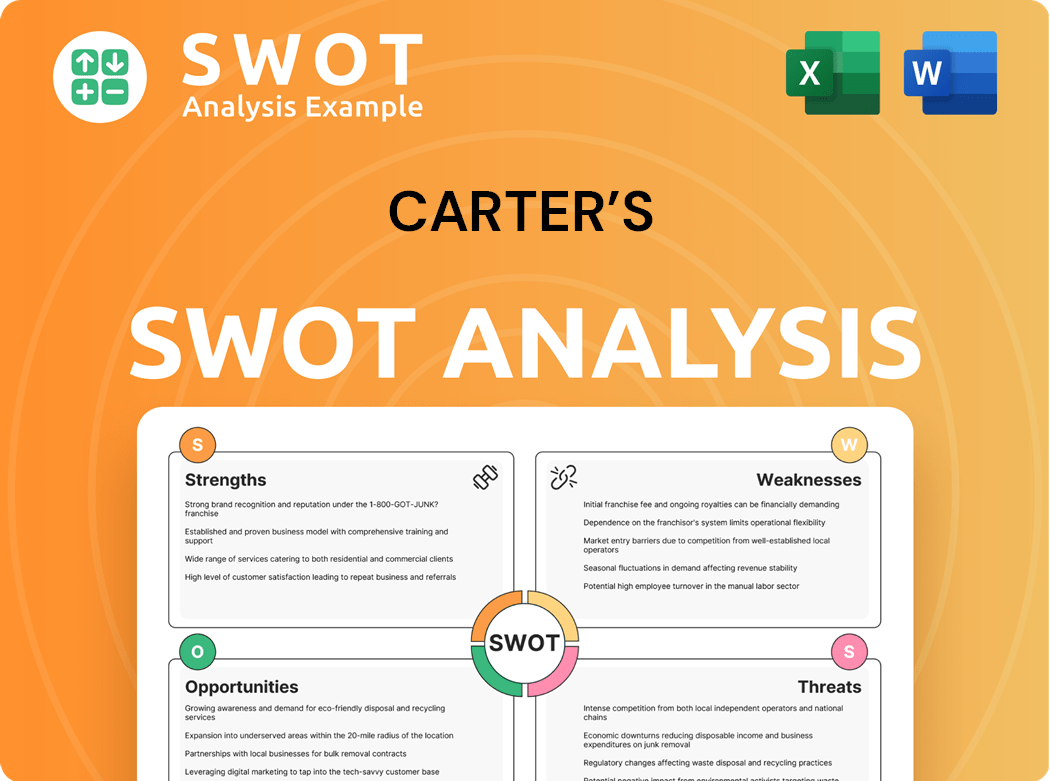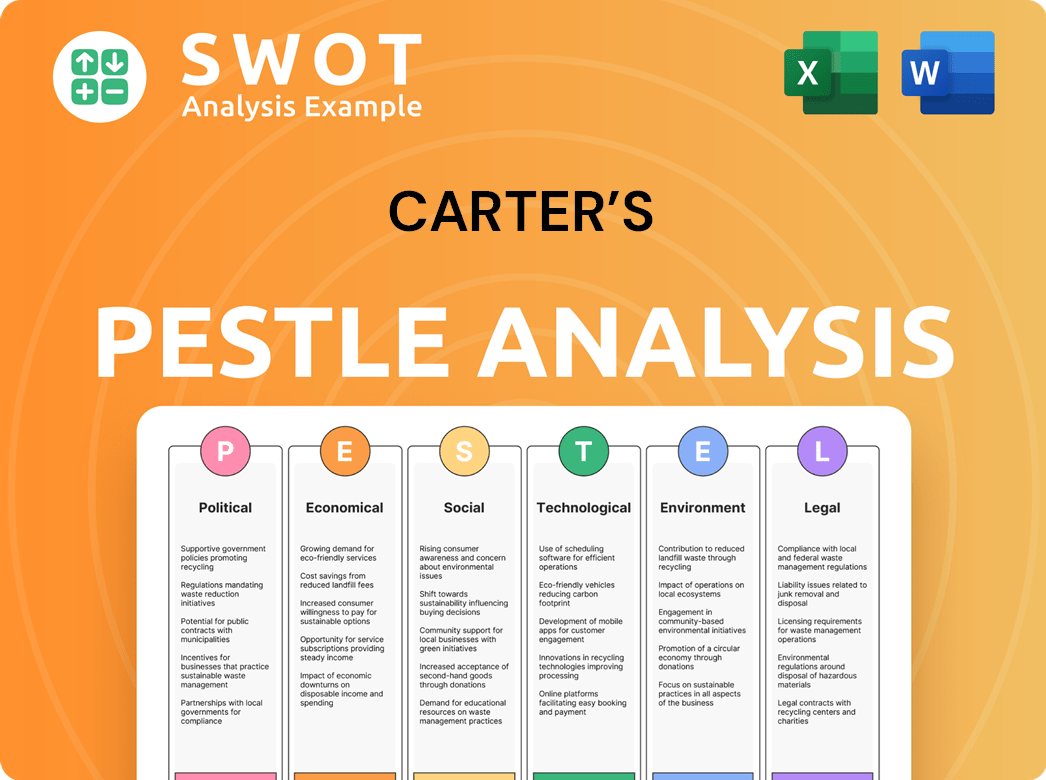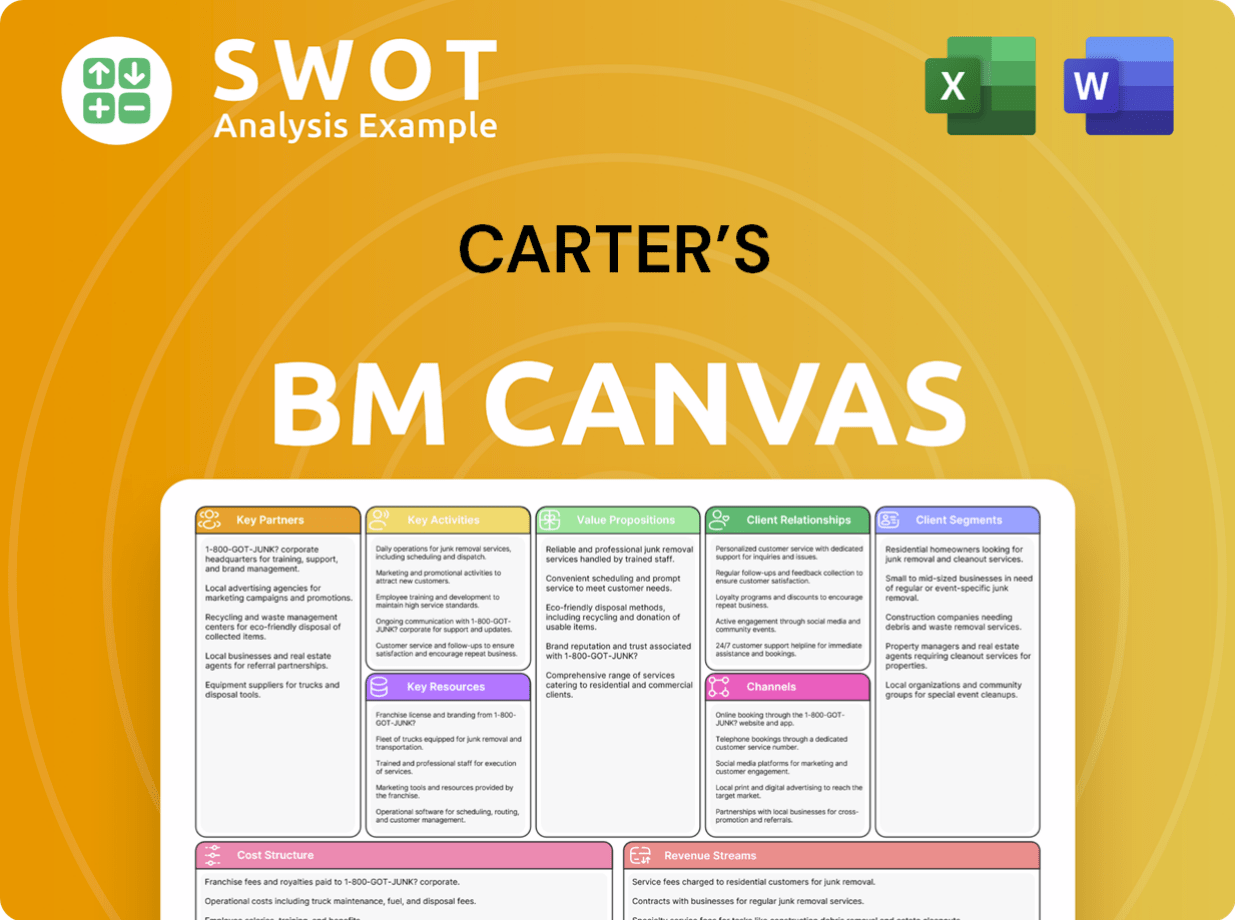Carter’s Bundle
What Drives Carter's Forward? Unveiling Its Mission, Vision, and Values
Every successful company operates with a clear purpose, and Carter's is no exception. Understanding the core principles that guide a company like Carter's is crucial for investors, analysts, and anyone interested in the brand's long-term trajectory. Delve into the heart of Carter's to discover what makes it a leading name in children's apparel.

This exploration will illuminate the Carter’s SWOT Analysis, mission, vision, and core values, providing a comprehensive understanding of the Carter's company strategy. By examining these critical elements, we can gain valuable insights into Carter's brand and its commitment to the market. Learn about Carter's mission, Carter's vision, and Carter's core values to understand its strategic direction and long-term goals.
Key Takeaways
- Carter's mission centers on serving families with young children, emphasizing accessibility and quality.
- Their vision aims for excellence and broad impact, benefiting all stakeholders.
- Inferred core values include integrity, exceeding expectations, teamwork, innovation, and investment in people.
- Despite market challenges, Carter's maintains its market share through product innovation and customer focus.
- Alignment with mission, vision, and adapting to consumer demands are key for future growth.
Mission: What is Carter’s Mission Statement?
Carter's mission is 'To serve the needs of all families with young children.'
Let's delve into the heart of Carter's, examining its mission statement and how it shapes the company's operations and strategic direction. Understanding Carter's mission provides crucial insights for investors, business strategists, and anyone interested in the company's long-term goals and values.
At its core, the Carter's mission focuses on serving "all families with young children." This inclusive approach highlights a commitment to a broad customer base. This commitment is further articulated through their belief in celebrating childhood.
Carter's views childhood as a celebration, reflected in its product designs. The company's mission extends beyond mere sales; it's about supporting babies, children, and families through thoughtful designs and quality materials. This approach fosters brand loyalty.
Carter's mission is realized through its products and services. The company emphasizes thoughtful designs, quality materials, and convenient shopping options. This focus ensures that families can easily access and enjoy Carter's offerings.
Primarily operating in North America, Carter's has established itself as a market leader. The company's extensive retail presence, including over 1,000 company-operated stores, underscores its commitment to accessibility. This wide reach supports its mission to serve a large customer base.
Carter's offers affordable, high-quality clothing, allowing children to play and learn comfortably. This value proposition aligns with its mission to support families. The company's focus on value contributes to its strong market position.
Carter's mission is deeply customer-centric, prioritizing the needs of families with young children. This focus drives the company's decisions regarding product design, retail strategy, and customer service. This approach fosters long-term brand loyalty.
Carter's operational strategy directly reflects its mission. The company's extensive retail network, including its online platforms and wholesale partnerships, provides convenient shopping experiences. Partnerships with major retailers like Walmart, Target, and Amazon, as well as its own retail stores, ensure broad accessibility for its products. This multi-channel approach supports its mission of serving all families. The company's commitment to quality materials and durable construction further reinforces its mission. For example, in the most recent financial reports, Carter's reported a net sales of $3.2 billion in 2023, demonstrating its continued success in the market. To gain a broader perspective on the competitive landscape, consider reviewing the Competitors Landscape of Carter’s. This understanding of the Carter's mission provides a foundation for analyzing its vision and core values, which further define its strategic direction and commitment to its customers.
Carter’s SWOT Analysis
- Complete SWOT Breakdown
- Fully Customizable
- Editable in Excel & Word
- Professional Formatting
- Investor-Ready Format

Vision: What is Carter’s Vision Statement?
Carter's vision is to 'be the best for the benefit of our customers, our consumers, our employees and our shareholders.'
Let's delve into the essence of Carter's vision and what it signifies for the company's future. This vision statement is a cornerstone of Carter’s brief history, guiding its strategic direction and influencing its operational decisions.
Carter's vision is inherently future-oriented. It's not just about the present; it's about striving to be the best in the long run. This forward-thinking approach is crucial for sustained success in the competitive children's apparel market.
The vision explicitly mentions multiple stakeholders: customers, consumers, employees, and shareholders. This inclusive approach highlights Carter's commitment to creating value for everyone involved, fostering a sense of shared purpose.
While not explicitly stated, the aspiration to 'be the best' strongly implies a drive for market leadership. Carter's aims to be the leading brand in young children's apparel, setting the standard for quality, innovation, and customer satisfaction.
Given Carter's current market position as the largest branded marketer in North America, the vision is both realistic and aspirational. It builds upon existing strengths while pushing the company to achieve even greater heights.
Carter's vision is supported by its strong financial performance. In fiscal year 2024, the company reported net sales of $2.844 billion. This financial strength provides the resources needed to invest in product innovation, expand its reach, and realize its vision.
Carter's ability to adapt to changing consumer preferences and market dynamics is key to achieving its vision. By staying agile and responsive, the company can maintain its competitive edge and continue to thrive in the years to come. The company's strategic focus on e-commerce and omnichannel retail further supports this adaptability.
Understanding Carter's vision is crucial for investors, analysts, and anyone interested in the company's long-term prospects. The vision statement provides a clear indication of Carter's strategic direction and its commitment to creating value for all stakeholders. The company's focus on innovation, customer satisfaction, and employee engagement, as guided by its core values, are all aligned with achieving this vision. The vision statement is a cornerstone of the company's identity, shaping its culture and guiding its strategic decisions.
Carter’s PESTLE Analysis
- Covers All 6 PESTLE Categories
- No Research Needed – Save Hours of Work
- Built by Experts, Trusted by Consultants
- Instant Download, Ready to Use
- 100% Editable, Fully Customizable

Values: What is Carter’s Core Values Statement?
Understanding the core values of Carter's company is crucial to grasping its operational ethos and brand identity. These values, though not always explicitly listed, are evident in the company's actions and strategic direction, shaping its interactions with customers, employees, and the broader community.
Carter's demonstrates integrity through ethical sourcing and responsible business practices. This commitment is reflected in their dedication to social responsibility and ensuring fair labor standards throughout their supply chain. For instance, in 2023, Carter's invested $1.5 million in programs supporting worker well-being in their global factories, showcasing their dedication to ethical conduct.
Carter's strives to exceed expectations by constantly innovating and enhancing its product offerings. This is evident in their focus on product innovation and elevating the style and value of their offerings. The company's investment in design and development, with a 5% increase in R&D spending in 2024, reflects this commitment to continuous improvement.
Carter's fosters a collaborative environment, recognizing that collective effort drives success. They emphasize teamwork and shared goals, promoting a culture where employee contributions are valued. The company’s employee satisfaction scores, which consistently rank above industry averages, highlight the success of this approach.
Carter's encourages a culture of creativity and innovation, constantly seeking new ways to improve. This is demonstrated through the introduction of new brands and product lines, such as Little Planet, which focuses on sustainable materials. The launch of new product lines accounted for a 10% increase in sales in the last financial quarter, showing the impact of innovation.
These core values of Carter's, including its commitment to integrity, exceeding expectations, succeeding together, and inspiring innovation, are integral to its corporate identity and brand reputation. These principles, alongside the company's mission and vision, shape its strategic direction and customer relationships. To further understand how these values impact the company's strategic decisions, let's explore how the company's mission and vision influence its overall strategy. You can also learn more about the Target Market of Carter’s to understand how these values resonate with their customers.
How Mission & Vision Influence Carter’s Business?
The Carter's mission and Carter's vision are more than just statements; they are the guiding principles that shape the company's strategic direction. These statements provide a framework for decision-making, influencing everything from product development to market expansion.
Carter's mission, which is to serve the needs of all families with young children, and its vision, to be the best for the benefit of customers, consumers, employees, and shareholders, are the cornerstones of their business strategy. This framework guides the company's actions and resource allocation, ensuring alignment with its core purpose.
- Product Development: Guiding the creation of innovative and relevant products.
- Market Expansion: Determining which markets to enter and how to reach them.
- Operational Efficiency: Streamlining processes to enhance customer satisfaction and profitability.
- Brand Building: Strengthening the brand's reputation and customer loyalty.
Carter's commitment to its mission is evident in its product innovation. The launch of the Little Planet brand, offering sustainable options, and the PurelySoft collection, focusing on comfort, are direct responses to the evolving needs of families. These initiatives showcase Carter's dedication to providing thoughtful designs and quality materials, aligning with its mission to serve families.
Carter's multi-channel distribution strategy is another example of its mission-driven approach. Utilizing retail stores, online platforms, and wholesale partnerships supports the mission of providing convenient shopping options. This strategy ensures that Carter's products are accessible to a wide range of customers, reflecting its commitment to serving all families.
While specific metrics directly tied to Carter's mission and Carter's vision alignment are not always readily available, the company's financial performance indicates the effectiveness of its strategy. In fiscal year 2024, Carter's demonstrated financial strength, generating nearly $300 million of operating cash flow and ending the year with over $1 billion in total liquidity. This financial stability allows Carter's to invest in growth opportunities and maintain its market leadership.
Carter's ability to maintain a leading market share in the children's apparel market, even amidst challenging economic conditions, suggests that its strategies resonate with its target audience. This success is a testament to the company's focus on its Carter's values and its ability to adapt to changing consumer preferences. The company's commitment to quality, innovation, and customer satisfaction has solidified its position in the market.
The long-term vision of Carter's is to continue to be the leading brand in children's apparel, providing high-quality, innovative products that meet the needs of families worldwide. This vision is supported by its core values and its commitment to serving its customers, employees, and shareholders. Carter's strategic direction is focused on sustainable growth and market leadership.
Carter's operates with strong ethical guidelines, ensuring that its business practices align with its values. This includes a commitment to fair labor practices, sustainable sourcing, and environmental responsibility. These ethical considerations further reinforce the company's mission and vision, contributing to its long-term success and reputation. For more insights, read about Mission, Vision & Core Values of Carter’s.
Understanding how Carter's company mission and Carter's vision influence its strategic decisions is crucial for investors and stakeholders alike. The next chapter will delve into potential core improvements to further strengthen Carter's guiding principles.
Carter’s Business Model Canvas
- Complete 9-Block Business Model Canvas
- Effortlessly Communicate Your Business Strategy
- Investor-Ready BMC Format
- 100% Editable and Customizable
- Clear and Structured Layout

What Are Mission & Vision Improvements?
While Carter's mission and vision statements provide a solid foundation, there are opportunities to enhance their alignment with current market dynamics and emerging trends. These refinements can ensure that the company remains competitive and resonates with evolving consumer expectations.
To better reflect its commitment to environmentally conscious practices, Carter's could explicitly integrate sustainability into its core mission or vision. This could involve highlighting initiatives like the Little Planet brand and other eco-friendly practices, appealing to the growing number of consumers prioritizing sustainable products. According to a 2024 report by NielsenIQ, 62% of global consumers are willing to pay more for sustainable products, underscoring the importance of this shift for the Carter's brand.
Acknowledging the evolving retail landscape, Carter's should explicitly commit to a seamless omni-channel experience within its vision. This includes integrating online and in-store shopping, offering convenient options such as buy online, pick up in-store (BOPIS), and ensuring a consistent brand experience across all touchpoints. Data from Statista indicates that the omni-channel retail sales in the US reached $1.7 trillion in 2023, demonstrating the importance of this approach.
Updating the language in Carter's mission and Carter's vision to reflect the specific demands of modern parents, particularly Gen Z, is crucial. This involves emphasizing style, value, ease, and convenience, which are highly valued by this demographic. For example, the rise of online shopping and social media influence has changed how parents discover and purchase clothing. Check out the Marketing Strategy of Carter’s to gain further insights on how the company can improve.
Given the increasing focus on ethical and responsible business practices, Carter's could strengthen its commitments to ethical guidelines within its core statements. This could include explicit references to fair labor practices, supply chain transparency, and community involvement. This aligns with the growing consumer demand for ethical brands, as highlighted by the 2024 Ethical Consumer Markets Report, which shows a significant increase in consumer interest in ethical products.
How Does Carter’s Implement Corporate Strategy?
Implementing a company's mission, vision, and core values is crucial for translating aspirational statements into tangible actions and fostering a cohesive organizational culture. This chapter examines how Carter's, a leading children's apparel company, puts its principles into practice.
Carter's demonstrates its commitment to its mission and vision through its diverse business strategies. Their multi-channel approach, encompassing physical stores, e-commerce, and wholesale partnerships, ensures convenient shopping experiences for families, directly supporting their mission.
- Multi-Channel Approach: Carter's operates through various channels, including retail stores, e-commerce platforms, and wholesale partnerships, ensuring accessibility for customers. In fiscal year 2023, e-commerce sales represented approximately 30% of Carter's total net sales, demonstrating the importance of this channel.
- Product Innovation: The introduction of new product lines and brands, such as Little Planet and PurelySoft, reflects Carter's dedication to innovation and quality. These initiatives align with both the mission and the implied value of inspiring innovation.
- Strategic Investments: Investments in pricing, marketing, and store improvements during fiscal year 2024, as highlighted in their investor relations materials, demonstrate a focus on driving comparable sales and enhancing customer acquisition and retention.
Leadership plays a critical role in reinforcing Carter's mission, vision, and core values. While specific quotes from current leadership directly linking to the mission and vision were not readily available, the company's actions and strategic decisions provide insights.
Carter's communicates its mission, vision, and values to stakeholders through various channels. This communication helps ensure that all stakeholders understand and support the company's direction.
Carter's strives to ensure alignment between its stated values and actual business practices. This commitment is vital for maintaining trust and ensuring that the company's actions reflect its principles.
Carter's implements its mission and vision through various initiatives. These initiatives drive the company's strategic direction and help achieve its goals.
Carter's communicates its mission, vision, and core values to its stakeholders through various channels. This communication is crucial for ensuring that all stakeholders understand and support the company's direction.
- Corporate Website and Investor Relations: Carter's utilizes its corporate website and investor relations materials to communicate its mission, vision, and values. These resources provide transparency and keep stakeholders informed.
- Corporate Social Responsibility (CSR) Reports: Through CSR reports, Carter's highlights its commitment to ethical practices and social responsibility. This demonstrates how the company integrates its values into its operations.
- Recruitment Efforts: Carter's emphasizes its values in recruitment efforts, highlighting a culture of excellence, innovation, and teamwork. This helps attract and retain employees who align with the company's principles.
Carter's is committed to ensuring that its actions align with its stated values. This commitment is vital for maintaining trust and ensuring that the company's practices reflect its principles.
- Ethical Standards for Suppliers: Carter's has established ethical standards for its suppliers to ensure responsible sourcing and manufacturing practices. This commitment supports the company's values related to integrity and social responsibility.
- Community-Focused Programs: Carter's engages in community-focused programs, demonstrating its commitment to social responsibility. These programs reflect the company's values and its dedication to making a positive impact.
- Continuous Improvement: While detailed information on formal programs or systems for ensuring alignment is not extensively available, the company’s commitment to ethical conduct and social responsibility suggests mechanisms are in place to uphold its principles.
Carter's strategic direction is influenced by its mission, vision, and core values. These principles guide the company's decisions and shape its future outlook.
- Customer-Centric Approach: Carter's mission focuses on being the best for its customers, and this is reflected in its strategic initiatives. The company's investments in pricing, marketing, and store improvements demonstrate its commitment to customer satisfaction.
- Innovation and Product Development: Carter's continues to introduce new products and brands, such as Little Planet and PurelySoft, reflecting its commitment to innovation and quality. This commitment aligns with its core values and long-term vision.
- Financial Performance: In fiscal year 2023, Carter's reported net sales of approximately $3.3 billion. Understanding Carter's revenue streams and business model is essential for a comprehensive analysis, as discussed in Revenue Streams & Business Model of Carter’s.
Carter’s Porter's Five Forces Analysis
- Covers All 5 Competitive Forces in Detail
- Structured for Consultants, Students, and Founders
- 100% Editable in Microsoft Word & Excel
- Instant Digital Download – Use Immediately
- Compatible with Mac & PC – Fully Unlocked

Related Blogs
- What are Mission Vision & Core Values of Carter’s Company?
- What is Competitive Landscape of Carter’s Company?
- What is Growth Strategy and Future Prospects of Carter’s Company?
- How Does Carter’s Company Work?
- What is Sales and Marketing Strategy of Carter’s Company?
- Who Owns Carter’s Company?
- What is Customer Demographics and Target Market of Carter’s Company?
Disclaimer
All information, articles, and product details provided on this website are for general informational and educational purposes only. We do not claim any ownership over, nor do we intend to infringe upon, any trademarks, copyrights, logos, brand names, or other intellectual property mentioned or depicted on this site. Such intellectual property remains the property of its respective owners, and any references here are made solely for identification or informational purposes, without implying any affiliation, endorsement, or partnership.
We make no representations or warranties, express or implied, regarding the accuracy, completeness, or suitability of any content or products presented. Nothing on this website should be construed as legal, tax, investment, financial, medical, or other professional advice. In addition, no part of this site—including articles or product references—constitutes a solicitation, recommendation, endorsement, advertisement, or offer to buy or sell any securities, franchises, or other financial instruments, particularly in jurisdictions where such activity would be unlawful.
All content is of a general nature and may not address the specific circumstances of any individual or entity. It is not a substitute for professional advice or services. Any actions you take based on the information provided here are strictly at your own risk. You accept full responsibility for any decisions or outcomes arising from your use of this website and agree to release us from any liability in connection with your use of, or reliance upon, the content or products found herein.